
(Values expressed in thousands of Brazilian Reais, unless stated otherwise)
1. OPERATING CONTEXT
Created in 1904, PREVI (the Banco do Brasil Employee Pension Fund) is a closed complementary pension entity which aims at instituting and managing Benefit Plans and is in compliance with the rules issued by the Ministry of Social Security by means of the Private Social Security Management Council (CGPC) and of the Office of Private Pension Plans (SPC).
The resources PREVI has available to it are composed of contributions made by its sponsors, essentially the Banco do Brasil S.A., and its participants, invested in parallel, and by the income derived from the investments made with these resources, which must comply with National Monetary Council (CMN) resolutions.
During the 2009 fiscal year, PREVI undertook several operations in the financial and capitals market with Banco do Brasil S.A. and with its subsidiary BB DTVM, as well as other financial institutions. It also has an agreement with Banco do Brasil for the rendering of financial liquidation and custody services for its fixed income and variable income assets, as per CMN Resolution n. 3456/2007, revoked by Resolution CMN n. 3792/2009 of 09/24/2009.
Investments are managed as a multi-fund, characterizing individualized resource management per Benefit Plan and indicating the assets are not invested collectively.
Complementary social security entities have been exempt of legal entity Income Tax since January 2005, pursuant to Law n. 11053, of 12/29/2004.
2. BENEFIT PLANS
PREVI manages three Benefits Plants, which are registered in the National Registry of Closed Complementary Social Security Entity Benefit Plans (CNPB).
Benefit Plan 1 – Defined Benefit. Participants of this Plan include those who were members of PREVI on 12/23/1997.
PREVI Futuro Benefit Plan – Variable Contribution (Defined Contribution for scheduled benefits, and Defined Benefit for risk benefits) instituted by Banco do Brasil S.A. and by PREVI for employees hired by the Bank since 1998. This benefit plan had its regulation approved by the SPC on 06/10/1998.
Sole Payment Benefit Plan – Savings Fund Portfolio – Capec – executes, under form and conditions determined in its own regulation, a savings system composed of plans aimed to cover death and disability, maintained by specific contributions made by its participants. Capec Plan’s assets are segregated and it has its own resources which are not mixed with those of the retirement and pension plans.
3. ACCOUNTING STATEMENT PRESENTATION
The 2009 Accounting Statements were prepared in compliance with the accounting practices in effect in Brazil and pursuant to CGPC Resolution n. 5, of 01/30/2002 and posterior amendments, following uniform principles, methods and criteria for Accounting Statements for the latest fiscal year.
The consolidated Accounting Statements include the Entity (Administrative Program) and Plan 1, PREVI Futuro, and Capec benefit plan account balances. Each Benefit Plan has its accounting structure based on three programs: Social Security, Administrative, and Investments.
4. MAIN ACCOUNTING PRACTICES
a) Investments
Fixed Income
Pursuant to CGPC Resolution n. 5, of 01/30/2002, amended by n. 10, of 07/05/2002, and CGPC Resolutions n. 4 and 15, of 01/30/2002 and 08/23/2005, respectively, the Fixed Income securities are entered at their acquisition cost, added to income calculated pro rata daily through the balance date and adjusted pursuant to the probable realization value. The premiums and discounts in the acquisition are amortized pro rata day in the term between the security’s acquisition and maturity date. They are classified in the following categories:
- Securities for trade - acquired to be traded regardless of the term to elapse after the acquisition date. The accounting appraisal is calculated based on the market value.
- Securities held to maturity – these are kept in the portfolio through their due dates, considering an opinion issued in a report that attests to the Entity’s financial capacity. The accounting appraisal criteria is that of marking based on the income curve proportionally (pro rata) through the due date.
Variable Income
Stock acquired in the stock market is entered based on their acquisition cost, added to brokerage expenses and other fees, and based on their market value on the closing date closest to that of the balance in the Stock Exchange where the stock has reached the most liquidity. Income, such as bonuses, dividends and interest on equity are calculated on the accrual basis.
Stock that was not traded in stock exchanges or in an organized over-the-counter market in a period of more than six months is appraised based on its latest equity value or based on its cost, whichever lower. CGPC Resolution n. 22, of 09/25/2006, also calls for the appraisal of these assets based on the own portfolio’s economic value.
The investment fund totals are represented by the value of their quotas on the balance date. Relevant assets allocated to these funds are being appraised based on their economic value, as stipulated by CGPC Resolution n. 4, dated 01/30/2002, and CVM Instruction n. 438, of 07/12/2006.
Investments in Real Estate
Investments in Real Estate are entered at their acquisition or construction cost and are periodically adjusted based on reappraisals. They are depreciated (except for plots of land) based on the linear method at a rate of 2% per year or at rates corresponding to the remaining usability set in the reappraisal reports. Facilities are depreciated based on the linear method at a rate of 10% per year.
Real Estate is reappraised periodically pursuant to the legislation in effect. The reappraisal adjustments, positive or negative, are accounted based on specific accounts as balancing entries with the result.
Operations with Participants
Operations with Participants correspond to Simple Loans and Mortgages and their balances include the principal, interest and monetary updating through the balance date.
b) Forecast for Loss and for Non-Performing Loans
Provisions were set for losses in investments, considering the risks and uncertainties, and for non-performing loans, pursuant to the criteria set forth in CGPC Resolution n. 5, of 01/30/2002. The provisions are accounted for in a result account, as a balancing entry with the reducer account for the respective asset’s segment. Therefore, the investments appear based on their net value.
c) Fixed Assets
Goods that compose the Fixed Assets are depreciated based on the linear method at rates set based on the useful life time determined per type. Expenses with software are amortized at a rate of 20% per year.
They are entered in the differed assets spent with organizational restructuring projects in the Information Technology and Social Security areas. When the project was concluded in November 2009, organizational restructuring expenses in the Information Technology field started being amortized. These expenses will be amortized at a rate of 20% per year.
d) Operating Liabilities
Known or calculable amounts are shown, added, when applicable, to charges and monetary variations represented by liabilities that derive from agreements signed with the Banco do Brasil sponsor, from the participants’ right to benefits and fiscal liabilities.
e) Contingent Liability
Represented by provisions constituted based on legal opinions rating contingencies that are likely to be lost. If rated as likely losses, they are shown in an Explanatory Note. When the likelihood of loss is remote, no treatment is given in the Accounting Statements.
PREVI’s management believes the constituted provisions suffice to meet possible losses resulting from administrative and/or legal suits.
f) Mathematical Provisions
The Benefit Plans’ Mathematical Provisions are calculated based on actuarial calculations, based on an opinion issued by Social Security Department professionals, and represent, at the end of each period, the accumulated commitments relative to the benefits that have been and will be granted to the assisted parties and to the participants.
Benefits Granted – the Entity’s future commitments to retired participants and dependent pensions.
Benefits to be Granted – the Entity’s future commitments to active participants.
Mathematical Provisions to be Constituted – the part of the provision to be constituted relative to Banco do Brasil employees hired until 04/14/1967, which has been complemented in the form of the Agreement signed in 1997 and amended in 1998.
g) Technical Surplus
Calculated based on the difference between the Net Assets (Total Assets deducted of Operating and Contingent Liabilities and funds) and the Mathematical Provisions. This is entered as a Contingent Reserve up to the limit of 25% relative to the Mathematical Provisions. Whatever surpasses this limit is entered in a Reserve for Plan Revision in each fiscal year, as determined by article 20 of Complementary Law n. 109, of 05/29/2001.
h) Funds
This registers constituted funds, as follows:
Pension Program – funds created based on the actuarial appraisal with specific destination. The exceptions are the Savings Portfolio and Certain Income Funds, which are both financial, and the Contribution Fund, which is budgetary.
Administrative Program – The purpose of the Administrative Fund is to ensure the future resources that are required to maintain the Entity’s administrative structure. The Fund is composed of the balance of the revenues, equivalent to 5% of the normal social security contributions of Plano 1 and PREVI Futuro, and 2.5% of the Capec contributions, among others.
Investment Plan – Funds aimed at liquidating simple loans and mortgages in the event of the borrower’s death, and of residues that exist after the contractual term in the event of financing, and credit risk in the loan portfolio, after exhausting all reasonable steps towards recovery. It is constituted based on the contractual fees charged of the borrowers.
i) Result Calculation
The result of the fiscal year is calculated on the accrual basis.
The Fiscal Year Result Statement is presented at the level of detail that is required to compose the result and calculate the technical surplus (or deficit) in the fiscal year, and to constitute mathematical provisions, contingencies and funds, separated by program.
j) Financial Flow Statement
The Financial Flow Statement indicates, on the cash basis, the asset variations that took place in the period and resource migrations between the Social Security, Administrative and Investment Programs.
l) Inter-program Transfers
These are used to identify resource movement among the programs by means of resource transfers, collections, and resources being transferred among the different expense natures of the aforementioned programs, using standardized criteria:
Pension Program – receives amounts from the Investment Program relative to the result of Benefit Plan resource investments and transfers amounts to the Administrative Program. In this Program, surplus or deficit is calculated after the respective transfers.
Administrative Program – receives amounts from the Investment Program relative to Administrative Fund investments, in addition to the amounts transferred from the Pension Program to cover administrative expenses. Leftover amounts, if any, constitute the Administrative Fund.
Investment Program – The monthly investment revenue (sales profits, monetary updates, interest, discounts, premiums, dividends, positive appraisal and reappraisal adjustments) is transferred to the Social Security and Administrative programs, according to each program’s resources, deduced of expenses (taxes, premiums, negative appraisal and reappraisal adjustments, losses in sales and provisions).
m) Administrative Costing
The net amount of the values transferred to the Administrative Program to cover the expenses with the social security management and of the investments made in the respective Benefit Plan.
The Administrative Costing originates in the following sources:
Social Security Administrative Costing – 5% of the ordinary social security resources collected per month in the Plano 1 and PREVI Futuro Benefit Plans and 2.5% of the contributions made to Capec. Expenses in excess of these percentages will be covered by the Administrative Fund.
Administrative Costing of Investments – Based on the monthly transfer of resources from the Investment Program corresponding to the administrative expenses incurred in this program’s management.
5. RECEIVABLE - PENSION PROGRAM
This group registers, among other amounts, the advanced payment of benefits the INSS is liable for and which are reimbursed to PREVI on the 5th business day of the subsequent month, for a total of R$121,358 thousand (R$113,642 thousand in 2008).
6. RECEIVABLE - INVESTMENT PROGRAM
The consolidated portfolio’s Investment Program totals the investments of three benefit plans. It is composed of Fixed Income, Variable Income, Real Estate Investment and Operations with Participants, topped out at R$142,461,953 thousand (R$116,570,702 thousand in 2008).
The following is PREVI’S Investment portfolio:
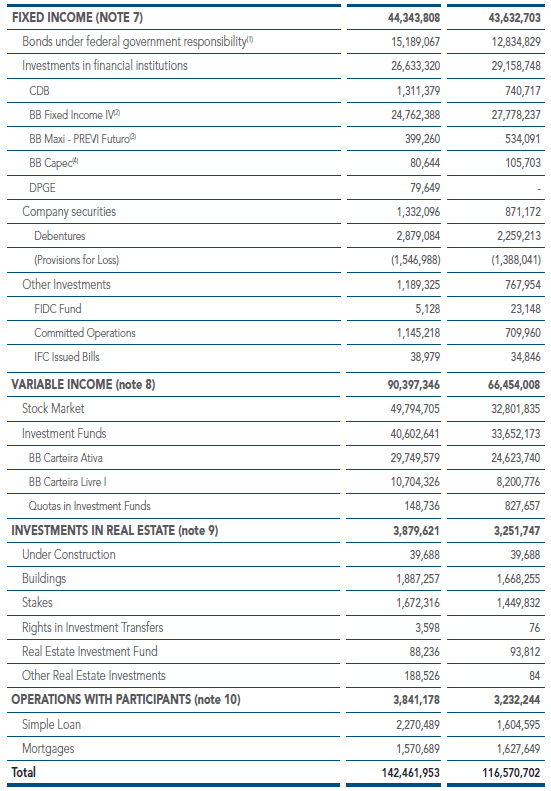
(1) Securities allocated to PREVI’s own portfolio.
Exclusive Investment Funds:
(2) 94.06% of assets allocated to bonds under federal government responsibility.
(3) 71.87% of assets allocated to bonds under federal government responsibility.
(4) 87.72% of assets allocated to bonds under federal government responsibility.
7. FIXED INCOME
The consolidated movements made in the Fixed Income portfolio, with a variation of R$ 711,105,000, was composed as follows: investments of R$ 15,192,037, divestments of R$ 15,651,659,000, positive asset variation of R$ 1,100,589,000, receivables of R$ 229,085,000 and provision for losses (debenture updates) of R$ 158,947,000.
Investments made in federal government bonds in PREVI’S own portfolio were enhanced to R$ 15,189,067,000 (R$ 12,834,829,000 in 2008). The resources came from input into PREVI’S cash flow, such as leases, real estate transfers, dividends and variable income asset sales, in the latter case, to contribute to adjusting the percentage of this segment in the limits required by CMN Resolution n. 3456/2007, revoked by CMN Resolution n. 3792/2009 of 09/24/2009. The investments are allocated to LFT (Financial Treasury Bills), bonds indexed based on the Selic rate, NTN-B (National Treasury Bonds – series B), indexed based on the IPCA inflation rate, NTN-C (National Treasury Bonds – series C), indexed based on the IGP-M, NTN-F (National Treasury Bonds – series F), pre-fixed, and LTN (Financial Treasury Bills).
Investments made in Financial Institutions include CDBs, DPGEs, and Investment Fund quotas, of which 97.5% belong to Benefit Plan 1 and the remaining 2.5% are distributed among the PREVI Futuro Plan and the Savings Portfolio.
On December 31st 2008 and 2009, the Fixed Income portfolio is demonstrated as follows per Benefit Plan:
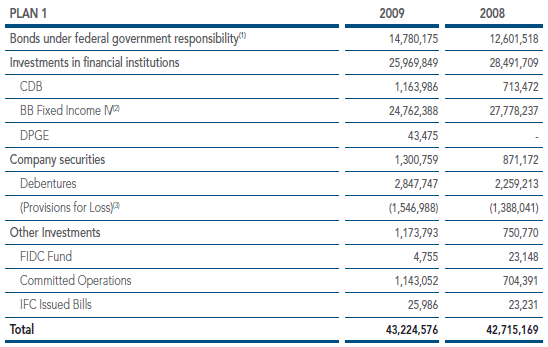
1) Securities allocated to PREVI’s own portfolio.
Exclusive Investment Funds:
(2) 94.06% of assets allocated to bonds under federal government responsibility.
(3) Debentures of companies Embaúba and Invesc, acquired from 1982 to 1999.
During the fiscal year, forecast for losses were calculated of Hopi Hari and Teka debentures, due to the debt payment deal.
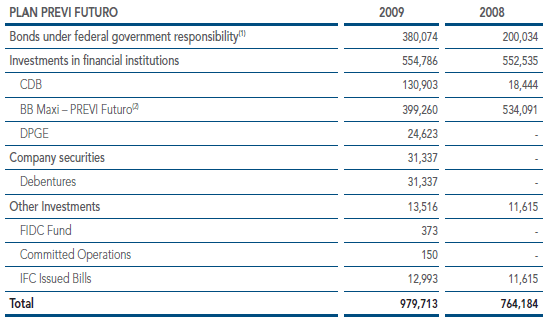
(1) Securities allocated to PREVI’s own portfolio.
Exclusive Investment Funds:
(2) 71.87% of assets allocated to bonds under federal government responsibility.
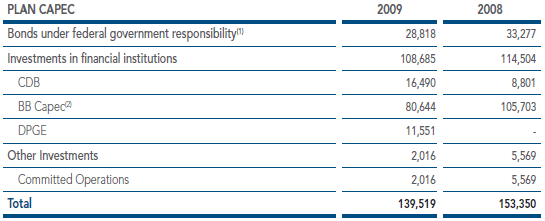
1) Securities allocated to PREVI’s own portfolio.
Exclusive Investment Funds:
(2) 87.72% of assets allocated to bonds under federal government responsibility
Part of the Litel Participações/Vale and 521 Participações/Neoenergia/Itapebi stock, belonging to Plan 1, migrated from the BB Fixed Income IV investment fund to the BB Active Portfolio and BB Free Portfolio I Variable Income funds, respectively. In 2009, these assets were reappraised based on the economic value criterion, as per items “b” and “c” of Note 8.
Pursuant to article 8 of CGPC Resolution n. 4, of 01/30/2002, the following are the amounts of the own portfolio securities allocated to exclusive Investment Funds, rated as “Securities for Negotiation” and “Securities Held through Maturity” (per due date range, in years):
a) Securities for Negotiation (includes exclusive Investment Funds)
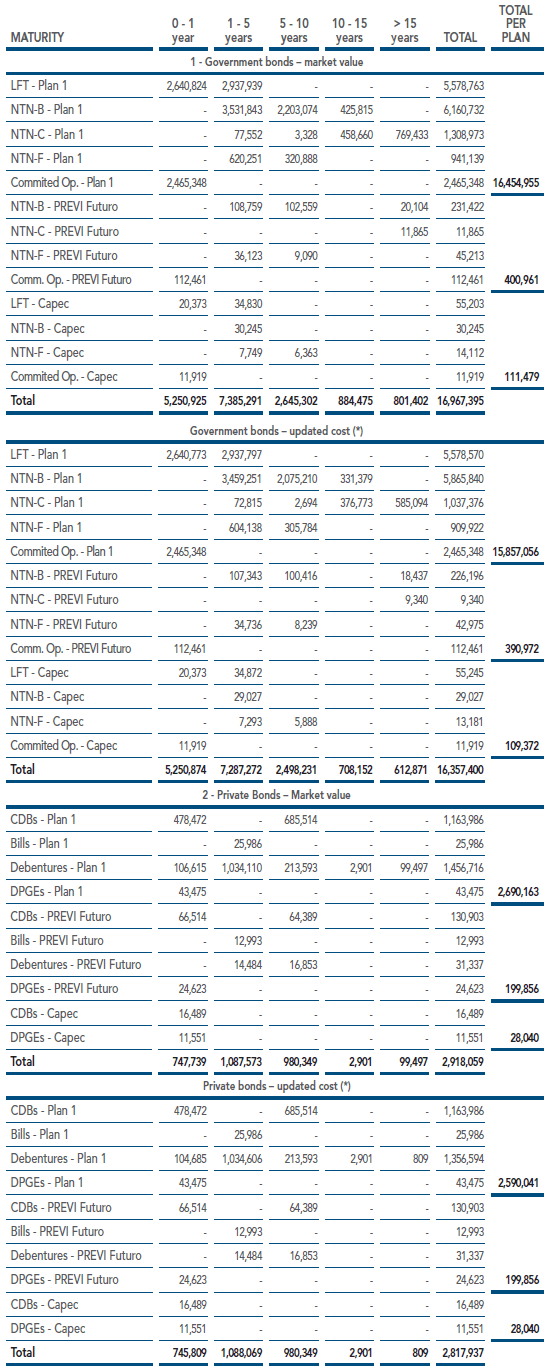
(*) Presented based on the updated cost for acquisitions for simple comparisons with those priced at market
value.
b) Securities Held through Maturity (includes exclusive Investment Funds)
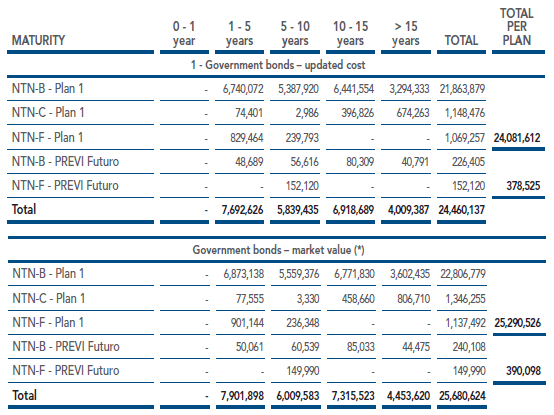
(*) Presented based on the updated cost for acquisitions for simple comparisons with those priced at market
value.
During the fiscal year, there was no reclassification of federal government bonds for the category “held through maturity”.
The Federal Government Bonds classified in the category “securities held through maturity” that were sold in 2009 as per CGPC Resolution n. 15 of 08/23/2005 are demonstrated below:
Plan 1 - Bonds: NTN-B (IPCA)
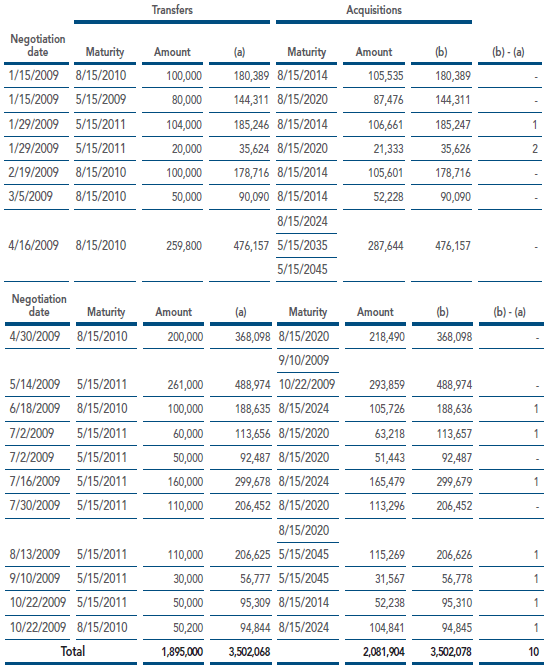
Plan PREVI Futuro - Bonds: NTN-B (IPCA)
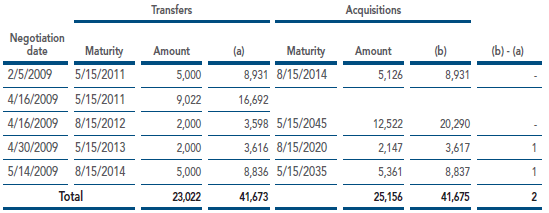
Justifications:
- The transfer operations carried out for federal public bonds, classified in the “Securities Held through Maturity” category, were done simultaneously to the acquisition of new securities of the same nature, with posterior maturity dates and for a total amount superior to the alienated securities, preserving the Entity’s intention when it classified such securities in the mentioned category;
- The security rollover operations for securities that had already been accounted for based on the yield curve (subparagraph “a”) were carried out in an exchange auction held by the National Treasury and justified as follows:
- mitigation of the risks of reinvesting the funds in Fixed Income;
- adjustment of the Federal Public Bonds to PREVI’s long-term cash flow, according to the cash needs pointed out by asset and liability managemen
The Entity has the financial capacity and intends to keep these securities through their due dates, as attested to by the Investment, Planning, and Social Security Departments.
8. VARIABLE INCOME
On December 31st 2008 and 2009 Variable Income portfolio is demonstrated as follows per Benefit Plan:
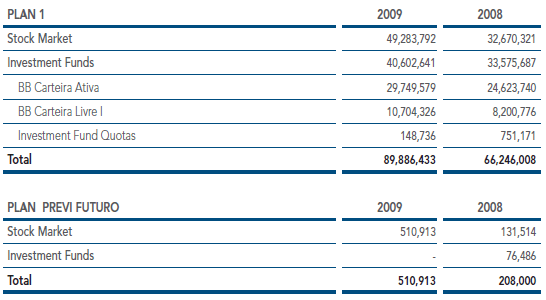
The consolidated Variable Income portfolio increase was R$ 23,943,338,000 resulting from the following events: investments of R$ 1,643,424,000, divestments of R$ 5,232,815,000 (sale of securities from the own portfolio and of those allocated to investment funds, redemptions and amortizations from investment funds) and a positive asset variation of R$ 27,532,729,000.
a) Stock Market
Plan 1 cash market includes securities of several companies. Among those with the biggest financial volume are: Petrobras, Banco do Brasil, Itaú Unibanco, Ambev, Bradesco, Embraer, Usiminas, Itausa and Brasil Foods (merger between Perdigão and Sadia during this fiscal year).
The following stock stands out in the PREVI Futuro Plan: Petrobras, Bradespar, Vale, Itaú Unibanco, and Bradesco.
The total of R$18,979,000 has been entered as a provision for loss. This total is for the accounting value of stock of companies that have entered into a composition with creditors, that are going through bankruptcy or for stock that is considered difficult to receive (Banco Econômico, Casa Anglo, Banco Nacional, and Gazeta Mercantil), acquired in the period ranging from 1991 to 1998.
b) Investment Funds - Plan 1
The stock of Litel Participações, a specific purpose corporation (SPC) which holds stakes in Valepar, the controller of Vale, are entered in the exclusive BB Carteira Ativa fund and in PREVI’s own portfolio. Since Litel’s stock is not traded in the market (although indirectly they represent Vale stock), these stakes have been being appraised based on the economic value criterion since 2002.
The value of PREVI’S participation in Litel was raised from R$ 28,553,590,000 in 2008, to R$ 31,082,710,000 in 2008, on account of the economic reappraisal made in 2009. A large part of this amount is allocated to the BB Carteira Ativa (R$ 29,556,488,000) and the rest to its own portfolio.
Stock belonging to CPFL, Neoenergia, 521 Participações (a specific purpose corporation that holds stakes in electric power sector companies Neoenergia and Itapebi) and Invepar (holding that controls companies in the highway concession sector Linha Amarela S.A. - LAMSA, Auto Raposo Tavares – CART, and Litoral Norte S.A. – CLN and company in the train concession sector Metrô Rio) are allocated to the exclusive BB Carteira Livre I Investment Fund.
In 2009, 521 Participações (R$ 3,467,298,000), Neoenergia (R$ 4,149,695,000) and Invepar (R$ 1,119,688,000), were priced at the economic value. The latter initiated the application of this criterion, due to the substantial increase in assets when acquiring Metrô Rio. Most of Neoenergia's value is in PREVI'S own portfolio (R$ 3,322,802,000).
In the reappraisal of 512 Participações, CPFL was not considered due to its migration to the BB Carteira Livre I Fund.

c) Stock without pricing in the past 6 months:
Own Portfolio – Plan 1
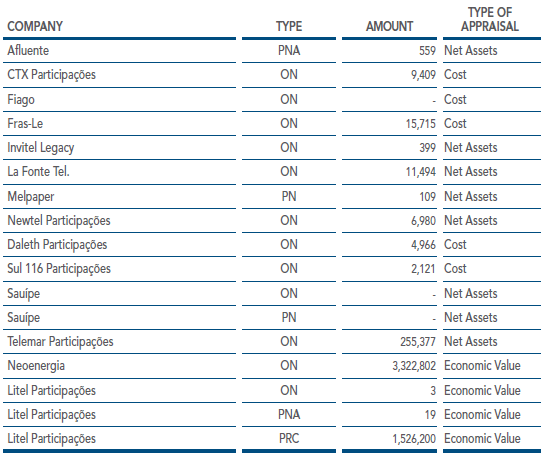
Exclusive Investment Funds – Plan 1
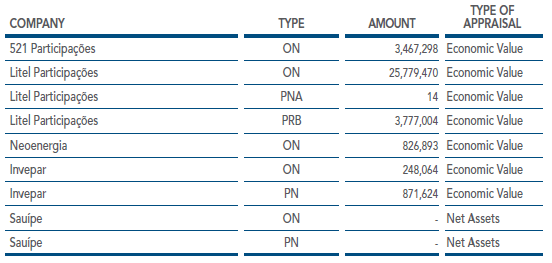
9. INVESTMENTS IN REAL ESTATE
Assets in this segment totaled R$3,879,621,000 (R$3,251,747,000 in 2008), distributed as per the demonstrative chart for item 6 of these Notes, belonging solely to Plano 1.
Of the 74 properties that compose PREVI’S portfolio, 49 were reappraised in 2009 based on reports issued by independent companies, generating a positive asset variation for the portfolio of R$ 495,091,000, as per the following charts:
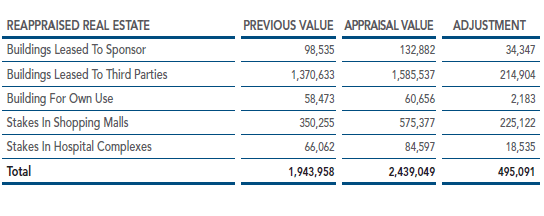

(*) The following companies have issued appraisal reports:
1 - Analítica Engenharia de Avaliações; 2 - Predictor Avaliações Patrimoniais e Consultoria Ltda.; 3 - CB Richard
Ellis Consultores Internacionais de Imóveis Comerciais; 4 - Cushman & Wakefield Semco; 5 - Sênior Consultoria,
Avaliações e Estudos Técnicos Ltda.; 6 - Pelli Sistemas Engenharia; 7 - Instituto UrbanoMétrica Pesquisa e
Desenvolvimento de Projetos Ltda.; 8 - Câmara de Consultores Associados S/C Ltda.; 9 - Avalibens Engenharia e
Avaliação Patrimonial Ltda.; 10 - Valor Engenharia Ltda.
The provisions for losses and non-performing loans in this segment added up to R$ 80,084,000 (R$ 238,967,000 in 2008), as per the following chart:

The provision for loss this fiscal year relative to advancements to be recovered from Fundação Umberto I was R$ 143.527,000, after observing the items in the judicial agreement with the São Paulo State Attorney’s Office through a Conduct Adjustment Term, which ended the dispute.
The provision for losses corresponding to the ordinary suit regarding the 7th floor and for the technical floor of the Centro Empresarial Mourisco was recognized as R$ 21,500,000 (R$ 22,780,000 in 2008), due to an agreement with Brascan on 07/09/2009, and there is no longer litigation between entities.
10. OPERATIONS WITH PARTICIPANTS
a) Simple Loans
The consolidated portfolio increased by R$ 665,894,000 compared to the previous year. The provision for non-performing debt for the Simple Loan portfolio accounts for 0.41% of the subgroup’s total.
b) Mortgages
In 2009, the portfolio balance was reduced by R$ 56,960,000, due to amortizations and liquidations, even though 775 mortgages were granted, for a total amount of R$ 105,460,000. PREVI is licensed by the Caixa Econômica Federal (CEF) to allow participants to use the resources in their Government Severance Payment Fund (FGTS) to complement the property’s purchase amount when the mortgage is granted.
The Operation with Participants portfolio on December 31st 2009 and 2008, per Benefit Plan, is presented as follows:
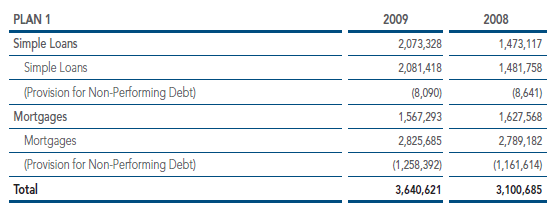
The Net Fund rate for Plan 1 participants is 0.1% per year. However, this fee has been suspended from 09/15/2009 until the next appraisal. The Liquidation per Death Fund (FQM) is 1% per year for Plan 1 participants.
In 2009, 748 mortgages were granted for Plan 1, 118 renegotiated agreements and 1,310 early payments in full. Of these payments, 39 participants used resources from their Government Severance Payment Fund (FGTS), amounting to R$ 2,492,000. The settlements with own resources totaled R$ 60,022,000. Liquidations with borrowers' own resources include those liquidated in credit retrieval, by DR/DRM and Warranty Replacement. Considering all categories, 1,665 contracts were liquidated.
The provision for non-performing debt of the Mortgages Portfolio of Plan 1 reached R$ 1,258,392,000 (R$ 1,161,614,000 in 2008). This growth resulted, mainly, from the update made to the debt stock based on the respective contractual indexes. Most of the delinquency is related to the 1995 period (VDP – Voluntary Dismissal Program carried out by the Banco do Brasil Sponsor) and corresponds to approximately 95% of the amount of delinquent contracts. The Mortgage Portfolio’s delinquency rate, on 12/31/2009, excluding agreements made between 1989 and 1995 and those renegotiated between 1998 and 2001, is 2.18%.
PREVI has been adopting a series of measures aiming at recovering delinquent credits. Of the 28,594 active agreements, 5,186 have installments that are more than 60 days late (position in December/2009). Most of these agreements are in implementation phase.

The Liquidity Fund rate of simple loan operations for PREVI Futuro Plan participants is 0.1% per year and the Liquidation per Death Fund (FQM) rate is 0.1% per year.
In 2009, 27 mortgages were approved for Plan PREVI Futuro, with a portfolio increase of R$ 3,315,000. One contract was liquidated with borrower’s resources at R$ 174,000. During the fiscal year, there was no provision for non-performing debt of the Mortgages Portfolio of Plan PREVI Futuro.
11. OPERATING LIABILITIES
The Operating Liabilities group is subdivided into the Social Security, Administrative and Investment Programs and registers liabilities derived from PREVI’s operations, with special emphasis on Plan 1’s Pension Program records.
a) BB x PREVI Agreement – Pre-67 Group
Anticipated amortizing contributions foreseen in the agreement signed between Banco do Brasil and PREVI on 12/24/1997, amended on 02/09/1998, to cost the benefits of employees who retired from the bank and of those who retire in the future and who were hired by 04/14/1967, are accounted for in the Pension Program.
With the implementation of the Mortality Table AT-2000, abandoning AT-83, and with the reduction of the interest rate to 5.50% per year, there was an increase in the bank’s commitment with benefit payments regarding employees hired until 04/14/1967, of R$ 625,483,000. This impact caused a balance shift between “Mathematical Provisions to be Constituted” and “Anticipated Amortizing Contributions” at
R$ 600,857,000, which was covered with the transfer of resources of the item “Future Resources – Parity – 2006 Agreement”.
The BB/PREVI agreement amounts reached the following totals on 12/31/2009:

(1) Updated based on the INPC + 5.75% per year.
b) Parity - 2006 Agreement
The Future Resources – Parity – 2006 Agreement item had the following movements in the year:

12. CONTINGENCY LIABILITIES
a) Contingency Liability – Probabilities
The following chart shows the composition of the contingency provisions per program, which register the occurrence of facts that merit decisions which may or not generate disbursements.

a.1) Pension Program
Based on a technical opinion issued by the legal department and observing the indicated risk classification, PREVI prepared a forecast to face the suits filed by participants and former participants. Almost all of these suits refer to Plan 1. The variation observed results from the increase in the number of suits in the year and from the constant follow-up on the legal risk attributed to existing suits. In addition to the provision constituted in this program, the amount of R$ 504,279,000 (position on 12/31/2009) is provided with its respective judicial deposit.
a.2) Administrative Program
The PIS/COFINS payments (R$ 1,926,000 – December/2009) will be deposited judicially in virtue of the Court Injunction filed on 07/13/2006 with a request for a preliminary injunction to guarantee the net and certain right to not submit PREVI to the collection of PIS and COFINS in the way required by Law n. 9718/1998.
The preliminary injunction was granted and a sentence handed down that partly affirmed PREVI's requests. Based on a legal opinion and considering the favorable court decision, the mentioned contributions have been deposited judicially since July 2006, which totaled, on 12/31/2009, a balance of R$ 45,411,000.
The program also provides the filing of grievances by former employees and former independent contractors against the Entity.
a.3) Investment Program
This program provisions the values of Plano 1 exclusively, regarding the fiscal contingencies related to Edifício São Luiz Gonzaga, the burden of defeat requested by the Federal Government with the restoration of undue payments suit regarding IOF tax restitution over income, and the compensation lawsuit by the condominium Edifício Verdes Mares.
The amounts aimed to regularize the grievance debts linked to the Fundação Umberto I project (R$ 21,574,000) are provisioned due to the compliance of the items of the judicial agreement with São Paulo State Attorney’s Office through a Conduct Adjustment Term, ending the judicial grievance procedure, as mentioned in Note 9.
Also this year, the reversal of the provision balance regarding the equalization of debit balance of mortgage contracts for the renegotiation or liquidation of New Carim (R$ 100,570,000), considering the existing balance in Hedge Fund (R$ 283,685,000) is enough to cover the risks for which the provision had been originally designed.
b) Contingency Liabilities – Possibilities
The liabilities with possibility of losing represent the sum of R$ 677,842,000 and involve issues related to social security, tax, employment, civil law, as well as other matters. Based on effective accounting norms, the constitution of provisions for these contingencies is dispensed.
c) Contingency Liabilities – Remote Loss
The administrative process concerning the tax assessment of Brazil’s Ministry of Internal Revenue regarding the Social Contribution on Net Profit – CSLL for 1997, amounting to R$ 3,506,499,000 (updated on 12/31/2009), revised its legal risk assessment from possible loss (in 2008) to remote loss, since the special appeal filed by the National Treasury was denied, thus sustaining the exemption of constitution of provision for losses.
13. ACTUARIAL LIABILITIES
The following Mathematical Provisions were determined based on actuarial calculations made by licensed Social Security Department professionals, as per the opinion on 01/28/2010.
The R$7,273,138,000 variation derived from the biometric actuarial premises used in the actuarial reappraisal of December 2009 for 2010, which contemplate the implementation of Mortality Table AT-2000, the reduction of the interest rate to 5.50% per year, and other actuarial variations, approved by the Deliberative Body on 12/18/2009.
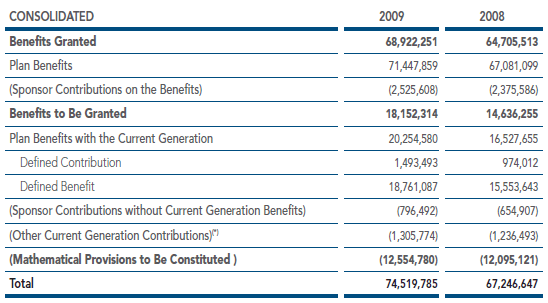
(*) Future personal and company contributions during hte participants labor years, minus the management fee.
a) Mutations of Mathematical Provisions (Consolidated)

14. MATHEMATICAL PROVISIONS – Benefit Plan 1
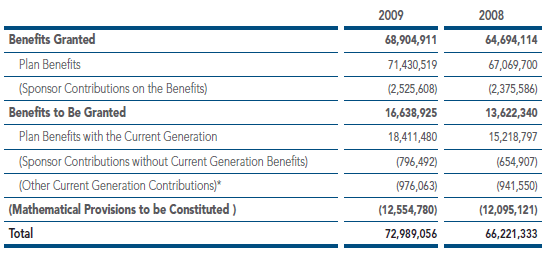
* Future personal and company contributions during hte participants labor years, minus the management fee.
These amounts were obtained based on the following Funding Plan:
Active Participants: according to the adjustment of their participation wages in the aliquots determined by the following table:

PS - Participation Salary; PP - PREV PartI
Obs.: On top of the resulting amount, there is still 25% relating to biennial compensation
Assisted Participants: 4.8% of the retirement complement amount;
Sponsors: amount identical to that of the contributions made by the participants.
In addition to these contributions, the Funding Plan for Benefit Plan 1 foresees, by means of an agreement
signed by BB and PREVI (Pre-67 Group), that the Bank will make contributions to maintain the balance of the “Anticipated Amortizing Contribution” account in balance relative to the “Mathematical Provisions to be Constituted” account. (Note 11-a)
15. MATHEMATICAL PROVISIONS – PREVI Futuro Benefit Plan

(*) Future personal and company contributions during hte participants labor years, minus the management fee.
These amounts were obtained based on the following Funding Plan:
The PREVI Futuro Plan is composed of two parts: Part I is structured as a defined benefit, while Part II as variable contribution.
The mandatory participant and sponsor contributions are equal and correspond to at least 7% and at most 14% of the participation wage.
16. TECHNICAL BALANCE
Benefit Plan 1
The positive result in the year, for the amount of R$17,890,684,000, added to the accumulated amount through 2008, raised the accumulated surplus to R$44,202,896, generating a coverage index of 1.61 actuarial commitments.
a) Contingency Reserve
Registers the asset surplus with regard to the actuarial commitments up to the limit of 25% of the Mathematical Provisions. In December 2009, the amount entered in this account added up to R$18,247,264,000 (R$16,555,334,000 in 2008).
b) Provision for Plan Revision
Registers the asset surplus with regard to the actuarial commitments for whatever surpasses 25% of the Mathematical Provisions. In December 2009, the amount entered in this item added up to R$25,955,632,000 (R$9,756,878,000 in 2008).
PREVI Futuro Benefit Plan
Because this is a variable contribution plan, the technical result of PREVI Futuro results from the values calculated in Part I of the plan, structured in the modality defined benefit from which the risk benefits are calculated.
17. FUNDS
Fund evolution is shown below:

Purposes:
(1) Constituted for the payment of personal and employer contributions during the year.
(2) Constituted for the payment of the Special Compensation Benefit to the participants based on the difference
between the 75% and 90% contribution cap.
(3) For Paying the Special Proportionality Benefit to participants, as per the calculation formula revision regarding
proportionality
(4) For Paying the Special Certain Income Benefit to participants who had surpassed 360 contributions by 12/31/2006
(5) Resulting from the possibility of there being a reduction in the amount of the PREVI Part – PP for the participants.
(6) Resources without destination specified in the current regulation on account of the participant severance or related
to specific events.
(7) Amounts required to rebuild the mathematical provisions of participants who are entitled to return to the PREVI
Futuro Plan.
(8) Constituted to face commitment oscillations and operating adjustments.
(9) Constituted with the purpose of ensuring payment of savings when there are insufficient availabilities.
a) Pension Program
The following schedule shows the investments, updates and usages until 12/31/2009:
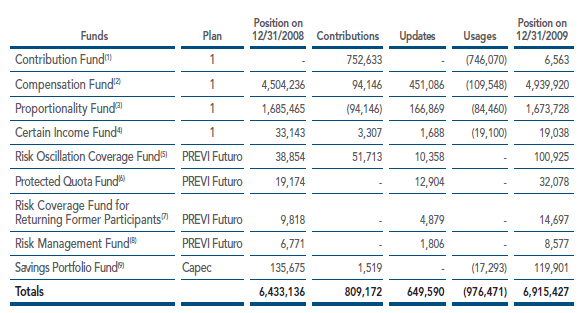
On 12/31/2009, there was an actuarial reappraisal of the Remuneration Funds and Proportionality Funds, which showed insufficient resources in the Remuneration Fund of R$ 272,656,000 and exceeding resources in the Proportionality Fund of R$ 94,146,000. As per paragraph 3, article 86 of the Regulation of Benefit Plan 1, there was a transfer of the exceeding amount in the Proportionality Fund to the Remuneration Fund, which reduced the imbalance to R$ 178,510,000. As determined in paragraph 4, article 87 of this Regulation, it was not possible to adjust the Reserve for Plan Revision in order to rebalance the fund.
The amount of R$3,307,000 was invested in the Certain Income Fund, using resources from the Plan Revision Reserve, regarding the inclusion of new beneficiaries on account of the survey of the respective financial bases.
According to the Actuarial Opinion of 01/28/2010, there was an investment of R$ 51,713,000 in the Risk Oscillation Coverage Fund, due to the result caused by Part I of Plan PREVI Futuro, where the risk benefits are calculated, due to the alteration of actuarial premises mentioned in Note 13.
b) Administrative Program
The Administrative Program Fund aims to ensure excess expenditures relative to the maintenance of PREVI’s administrative structure. It is constituted by the positive result found in the Program’s revenue and expense calculation.
In December 2009, the Administrative Fund added up to R$693,849,000 (R$552,505,000 in 2008).
c) Investment Program
The Investment Program’s Funds are constituted of percentages, charged monthly in the Simple Loan and Mortgage installments, as determined in the Regulations in effect.
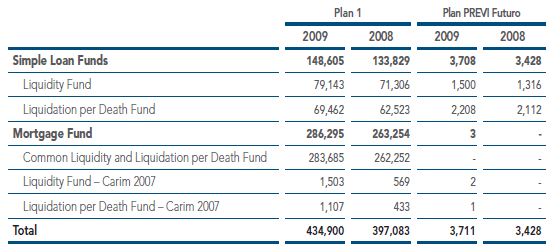
The Liquidation per Death Funds are aimed at liquidating obligations falling due in the event of the borrower’s death.
In the Real Estate portfolio, the Liquidity Fund aims to cover possible existing residues at the end of the contractual term, except those related to delinquent amounts, and to support discounts in the owing balances for mortgage contracts that adhere to the New Carim.
In the Simple Loan portfolio, the appropriate Liquidity Fund resources are aimed to ensure the coverage of the portfolio’s credit risk after all possible measures to recover delinquent credits have run out.
18. RESULT STATEMENT
The following chart shows the result’s summarized composition without inter-program transfers:

The result of the fiscal year was positive by R$17,890,684,000 (negative by R$26,625,628,000 in 2008). As a consequence, the accumulated surplus, R$26,312,212,000 in 2008, rose to R$44,202,896,000. The positive profitability of the investments made in Variable Income (39.6%), and Fixed Income (12.9%), and Real Estate Investment (24.4%), which were above the actuarial goal of 10.1% (INPC +5.75% per year), contributed to this picture.
The Variable Income segment, with a participation of 63.5% in the investments at the end of the fiscal year, was strongly influenced by the good performance of the Stock Exchange.
a) Pension Program
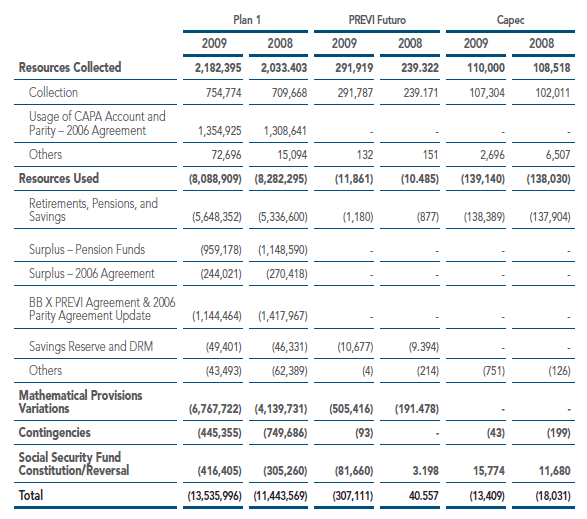
CAPA Account: Anticipated Employer Amortizing Contributions
b) Administrative Program
The Administrative Program consumed R$323,732,000 (R$64,659,000 in 2008). This sum results mainly from investments in the Administrative Fund in the amount of R$ 141,344,000 (regression of
R$ 92,367,000 in 2008) and administrative expenses, which reached R$ 170,106,000 (R$ 147,740,000 in 2008). These expenses correspond to 14.8% of normal pension contributions.
In order to identify the administrative expenses incurred by the common areas, we used pro rata criteria based on the expenses incurred with personnel assigned to each area (social security and Investment), on the number of employees, and on the percentage of the physical area occupied by these activities.
The participation percentage of the assets of each plan is applied to the investment’s administrative expenses to calculate the investment’s administrative costing for the Benefit Plans.
By applying the pro rata parameters among the programs, the calculated percentage was 32.4% for social security administration and 67.6% for investment administration.
c) Investment Program
This group registers the incomes and liquid variations derived from plan resource investments, which generate a 28.2% profit in Plan 1, 27.2% in Plan PREVI Futuro, and 11.5% in Plan Capec, as follows:
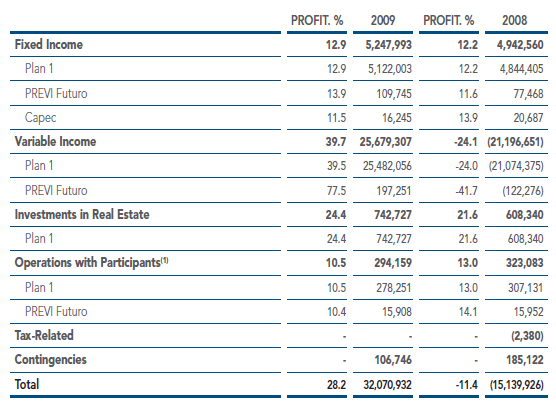
(1) Including the variation of Simple Loan and Mortgage Funds.
The following events, among others, determined the result attained with Variable Income: (i) positive variation in the stock market (R$21,637,666,000), including income from dividends/interest on equity in own portfolio (R$1,830,769,000), (ii) net variation in investment funds (R$4,041,641,000), including adjustments made to the economic value of Litel/Vale, 521 Participações, Neoenergia, and Invepar.
Of the Investment Program’s positive result of R$32,070,932,000, a total of R$31,803,675,000 was transferred to the Pension Program, R$267,257,000 was transferred to the Administrative Program, and R$114,949,000 as administrative costing for the investments and R$ 152,308,000 as administrative fund remuneration.
19. COMPLEMENTARY INFORMATION
After 2010, the Accounting Statement will be elaborated in conformity with CGPC Resolution n. 28 of 01/26/2009, which revokes, starting 01/01/2010, the CGPC Resolution n. 5 of 01/30/2002 and subsequent alterations. The legal provision aims to provide greater transparency of accounting information to participants in the private pension system, which aligns to the International Accounting Standards. Among the major changes, we can cite the mandatory accounting segregation of the Administrative Management Plan and the demonstration of the Net Assets of each Benefit Plan.
Sérgio Ricardo Silva Rosa
President
CPF 003.580.198-00
Francisco Ferreira Alexandre
Management Director
CPF 301.479.484-87
Luiz Felipe Dutra de Sousa
Accountant CRC RJ 64386/O-3
CPF 796.164.107-68
